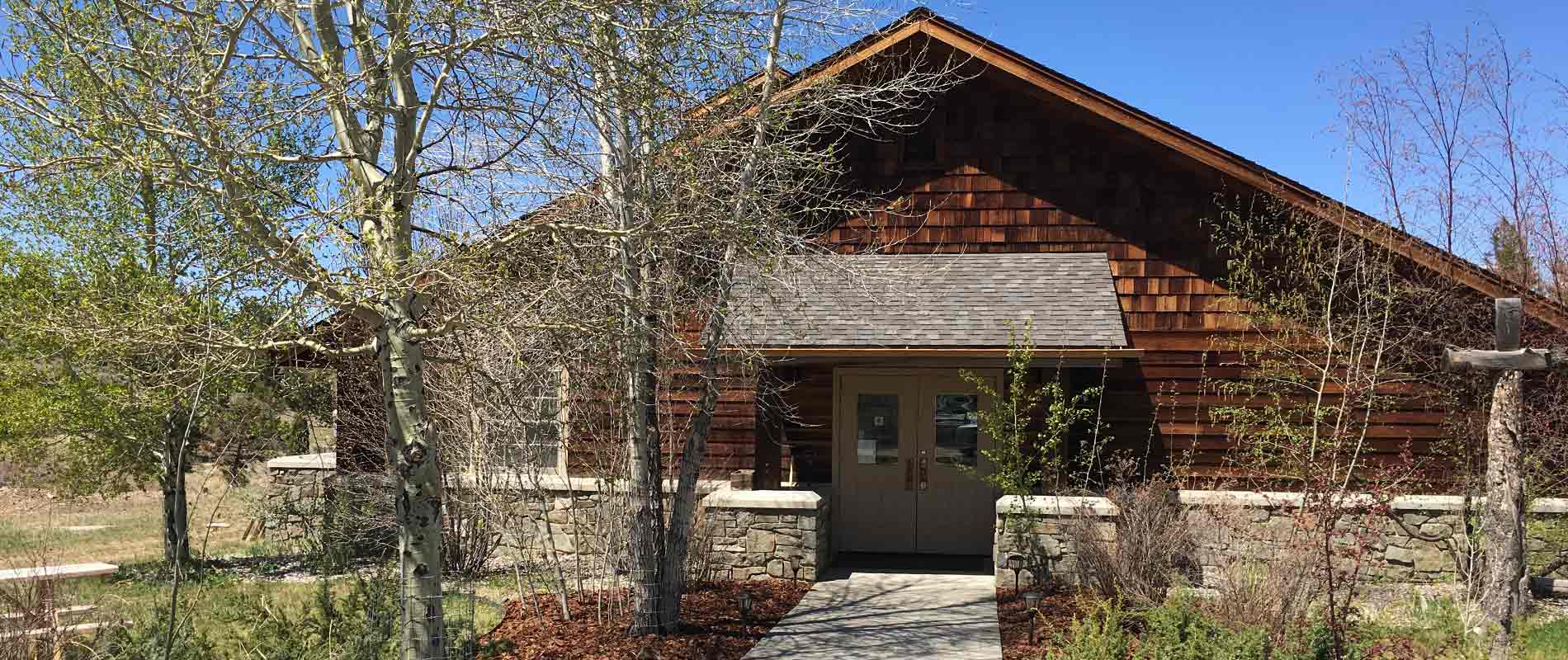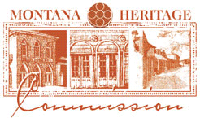Preserving such a vast collection of primarily "old west" artifacts is a slow process. As items are documented, they are added to the database. Take a peek for yourself and enjoy learning more about America's past. Click here to view our Collections Gallery.
Virginia City and Nevada City, Montana are home to over one million Americana artifacts housed in 248 historic buildings. Curatorial Staff research, catalog and manage the collection with the assistance of volunteers. It is the responsibility of the Curatorial Staff to manage the objects long-term physical well-being and safety. Care is taken to preserve the artifacts in their current environment but active use of objects has adverse effects, so some are moved to a secure storage area at the McFarland Curatorial Center. Each object must be identified, documented, and actively stabilized using current museum standards of care. Dirt, debris, and damage are not "patina" or "historic character" and we are removing these dangers, but it takes time, money, and people. It is a slow but very important process that connects the artifacts not only to the general history of the sites and the Bovey family's involvement, but also identifies their national significance.
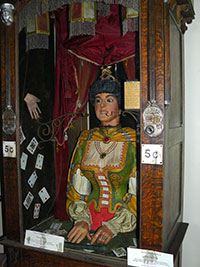
The objects in the Virginia City and Nevada City collections are irreplaceable. Even those that are less attractive to our modern eyes, or common in antique stores, have value in our collections because they were specifically collected for or used here. Historic value has no monetary equivalent. Whether you see a single artifact that is rare, like the Gypsy Verbal Fortune Teller or a diverse collection, such as the 100+ music and arcade machines throughout the sites, each object is a part of history and needs the appropriate attention. To view our wonderful collection of music machines and hear some play, visit www.virginiacitymusic.com. Through research we gain greater understanding of our past and the cultures in which the objects were created.
You can request a copy of our annual report by contacting us at 406.843.5247.
If you would like to be involved as volunteer, check out the volunteer opportunities available.
If you would like to become a benefactor, please contact us. We are always happy to accept donations as well.
A Glimpse of Past Restoration Projects
As funds and time allows the Montana Heritage Commission continues to restore historical treasures.
Preserving the Standard Harness of America Poster
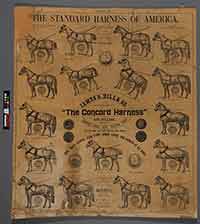
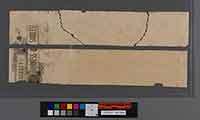
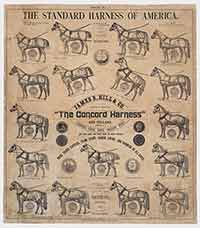
MHC and the National Stagecoach & Freight Wagon Association (NSFWA) entered into a partnership to conserve a poster that was displayed in the Joseph Sullivan Saddlery shop in the Nevada City Living History Museum. NSFWA is dedicated to the interpretation, education and preservation of the legacy of commercial stagecoaches and freight wagons which were integral to the development of the western United States in the 19th century. The c. 1886 James R. Hill & Co. "The Standard Harness of America" poster is very rare and needed stabilization for its long-term preservation. The NSFWA very generously donated funds to have the poster conserved.
MHC Collections department chose the Conservation Center for Art & Historic Artifacts (CCAHA) in Philadelphia, PA for the conservation treatment and the poster was carefully packed and shipped to them. There the print was removed from its acidic backing, cleaned numerous times using several techniques, and was strengthened and stabilized with mulberry paper lining. Once conservation was complete, the document was digitally scanned. Using that scan, an exhibition-quality facsimile was printed, to be used for display while the conserved poster is protected in long-term storage at McFarland Curatorial Center.
After delays due to Covid shutdowns, we received the preserved Concord Harness poster from CCAHA, and the difference was stunning! The poster arrived with the facsimile, a disc containing all the conservation procedures for our records, plus a reproducible image of before treatment and after treatment. Thanks go to CCAHA for their exemplary work and a Very Big Thank-You goes to the National Stagecoach & Freight Wagon Association for funding this project and for saving an important piece of transportation history!
The Nymphs and Satyr located in the Bale of Hay Saloon
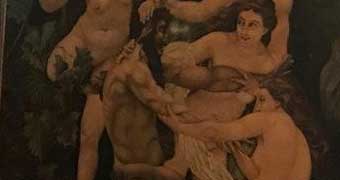
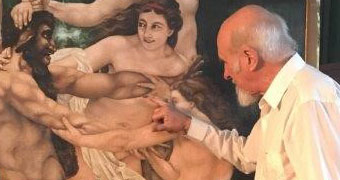
At the end of our 2017 season, Fine Art Conservator Nathan Terre arrived to pick up the Nymphs & Satyr painting from the Bale of Hay Saloon, for conservation at his Missoula studio. With help, the large painting was taken down, carried out and safely nestled on a custom made flexible frame in the enclosed truck. Nathan has been hired to clean and stabilize this object for long term preservation.
This painting in the Virginia City - Nevada City collection is a copy of “Nymphs & Satyr” painted by French artist William Bouguereau. It is thought that the American collector who bought the Bouguereau painting in Paris in 1873 also had the McLaurin painting commissioned for display in one of his hotel bars. The c. 1890 oil on canvas painting by L.M. McLaurin was purchased by Charles Bovey around 1940 from the Great Falls Air Force Base Officer’s Club. Bovey loaned the painting to the Tammany Bar, Montana Hotel, in Anaconda before it was hung in the Bale of Hay Saloon in 1983.
A member of the Collections Department visited with Nathan Terre, Fine Art Conservator, in Missoula several times during this time to check on the progress on the Nymphs & Satyr painting. Using his masterful conservation skills, Nathan slowly removed the many layers of hardened and darkened varnish on the painting. The varnish was so thick that he had to soak an area in a special solvent and then return to it to begin careful removal. The results were amazing, as shown in the photos. The difference between darkened and clean are quite a contrast! A new plexiglass covering was also installed over the painting to protect it when it hangs in the Bale of Hay Saloon.
The Nymphs & Satyr was returned in the spring of 2018 and currently hangs on the back wall of the Bale of Hay Saloon in Virginia City. Be sure to stop by between Memorial Day weekend and mid September to check it out.
Revive and Rebuild the Famous Obnoxious Horn Machine in Nevada City
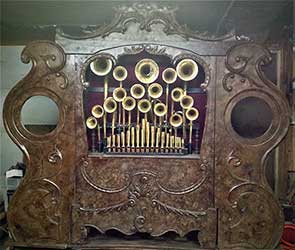
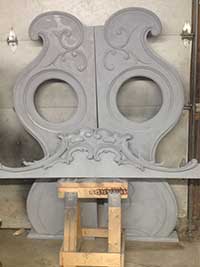
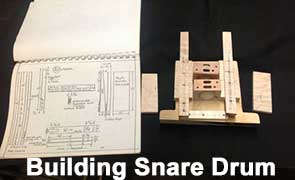
The Wurlitzer 150 Band Organ (serial # 2741) earned the reputation of the “famous and obnoxious horn machine” of the Bale of Hay Saloon, and was somewhat symbolic of the beloved “funky” atmosphere of not only the Bale of Hay but other aspects of Virginia City as a whole. It was moved to Nevada City in the mid 1970’s after Bale of Hay patrons threatened to silence it, but its loyal following continued to seek it out. No visit to Nevada City was considered complete without experiencing the musical abilities of the Obnoxious Horn Machine.
The front facades, drums, and cymbal were removed in the 1950's, making it smaller to better fit in the Bale of Hay Saloon and reducing the volume of sound from the drums and cymbal. Today the organ is in the Nevada City Music Hall where there is enough room to have the missing parts added to give the public the full sound of this magnificent instrument. When the organ is without the percussions (drums and cymbal) it is missing so much of the music. The Wurlitzer 150 is one of the last great trumpet organs in existence today.
The music machines were collected by Charles Bovey and is one of the largest collections in the West, and is noted as the largest publicly owned and publicly displayed music and arcade machine collection in the United States. A New York Times article sited our overall collection of Americana as the second largest in the United States, outside the Smithsonian. In 1997, the State of Montana committed 6.5 million dollars to purchase this important cultural resource, much of which had 20 years of deferred maintenance.
Most museum collections are for exhibit only. With the help of donors, volunteers, knowledgeable experts, community groups and other funding, this Wurlitzer 150 band organ and others in the collection are or will be on display and ready for public use. People can put a few coins in and hear the music and see the action of this beautiful piece of history. This Wurlitzer 150 is one of only a couple dozen in the world today.
In 2018 & 2019 the Montana Heritage Commission received a grant from the Montana History Foundation to help rebuild the Wurlitzer 150 Band Organ as it now exists. This included recovering the pumps, all new belts, valves, along with replacing springs and pneumatics. Brass pipes and chambers were also cleaned and resealed. The missing acorn pieces which is what tunes the organ was remanufactured and replaced. A custom-built top crest was installed and façade sides were added and adapted from pieces in our collection. A bass drum and snare drum was added along with custom built new player mechanism for the drums and cymbal. We are so glad to have another working music machine on display for people to listen to in the Nevada City Music Hall.
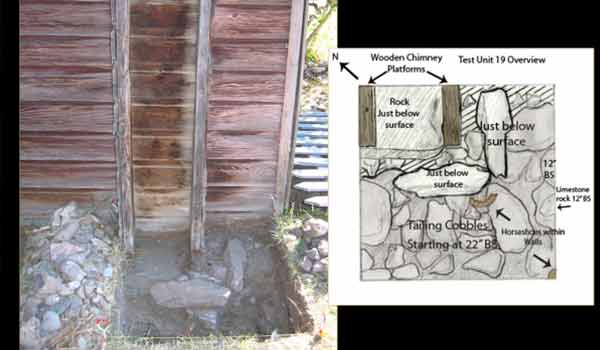
The Montana Heritage Commission's Archaeological Program is responsible for overseeing all ground disturbing activities on state property in Virginia City and Nevada City. The Archaeological Program identifies, monitors, and excavates cultural heritage sites, which are threatened by needed construction, repair, or improvement projects. The cultural heritage sites in those cities come in many more forms than just standing historic structures, actually the most valuable cultural resources still remain mostly unknown as they lie beneath the back roads and now empty city blocks.
The history of the early days of Montana's richest gold placer town still has a lot to tell and the rest of the story can be told through the archaeological record. This usually gives us a better understanding of people's every day lives, which is often not present in historical records. The archaeological record can also give us important information about the prehistory of the sites before the gold rush swept through the gulch.
As stewards to an important part of our history, the Archaeological Program, through excavations in the summer time, reaches out to the general public about what lies beneath our feet.
The program is currently staffed with seasonal contracted help when needed. However, the program mostly relies on volunteer help. The Archaeological Program is guided by the Archaeological Management Plan, which details the various steps and procedures. The plan was drafted in accordance with federal and state laws in regards to the protection of Cultural Heritage Resources and other agreements.
Find out how you can help preserve these precious artifacts by visiting our volunteer page.
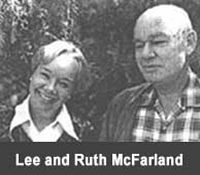 Construction of the McFarland Curatorial Center was completed in 1999 as a major step toward caring for artifacts in Virginia City and Nevada City. This is a year-round facility for the storage, research, conservation, and interpretation of the extensive collection owned by the state of Montana. The building was made possible by a grant from Ruth McFarland in memory of her husband Lee (1920 - 1994). The commission's curatorial staff and volunteers are based in this building.
Construction of the McFarland Curatorial Center was completed in 1999 as a major step toward caring for artifacts in Virginia City and Nevada City. This is a year-round facility for the storage, research, conservation, and interpretation of the extensive collection owned by the state of Montana. The building was made possible by a grant from Ruth McFarland in memory of her husband Lee (1920 - 1994). The commission's curatorial staff and volunteers are based in this building.
The center operates under a Collections Management Plan that articulates the purpose of the collection and methods of achieving this purpose. It includes the following topics: scope of collections; acquisition policy; loan policies; access to artifacts; de-accession policies; conservation of artifacts; a housekeeping plan for the furnished building displays and other exhibits; inventory and record keeping procedures; access policies; insurance; reproduction and copyright; Native American Graves Protection and Repatriation Act and other laws; education or research collection; and public disclosure.
